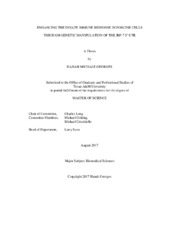| dc.contributor.advisor | Long, Charles R | |
| dc.creator | Georges, Hanah Michale | |
| dc.date.accessioned | 2018-02-05T21:20:28Z | |
| dc.date.available | 2019-08-01T06:53:09Z | |
| dc.date.created | 2017-08 | |
| dc.date.issued | 2017-07-26 | |
| dc.date.submitted | August 2017 | |
| dc.identifier.uri | https://hdl.handle.net/1969.1/166011 | |
| dc.description.abstract | Viral epidemics in the pork industry continue to plague the agricultural industry, national food security, and human health. Current preventative measures are insufficient for deterrence as viruses rapidly mutate and reemerge despite vaccinations and biosecurity. In order to prevent viral outbreaks within and between pork facilities, alternative measures are needed.
The innate immune system is a host’s first response to pathogens. It offers a rapid response; however, it does not have the specificity which is seen in the adaptive immune system. In its initial response, cytokines IFNα and IFNβ induce expression of interferon stimulated genes to inhibit viral replication within the cell. IRF-7 has been identified as the master regulator of type I IFN transcription and is tightly controlled by OASL and 4E-BP1, binding to the secondary structure of its 5’ UTR. To enhance the innate immune system response to viruses, the DNA sequence for the 5’ UTR of IRF-7 in porcine cells was modified using the CRISPR/Cas9 gene editing system. Following UTR modifications, 9 modified cell lines were produced and clonally selected, along with 2 control cell lines that were not modified. All cell lines were transfected with poly I:C to induce the innate immune response and transcript levels of genes associated with the IFN pathway analyzed by RT-qPCR.
Deletions induced by the CRISPR/Cas9 system in cell lines successfully altered the IRF-7 5’ UTR DNA sequence in 82% of cells. RNA folding predictions of the two modified cell lines with a heightened immune response show drastic alterations to the IRF-7 5’ UTR in regions hypothesized to be critical for IRF-7 translational regulation. Understanding the relationship of the 5’ UTR secondary structure and IRF-7 regulation allows for the possibility of enhanced innate immune responses in animal models with IRF-7 5’ UTR modifications or even in targeting the IRF-7 5’ UTR in humans using pharmacological substances. | en |
| dc.format.mimetype | application/pdf | |
| dc.language.iso | en | |
| dc.subject | IRF-7 | en |
| dc.subject | 5' UTR | en |
| dc.subject | Porcine | en |
| dc.subject | Interferon Regulatory Factor 7 | en |
| dc.title | Enhancing the Innate Immune Response in Porcine Cells Through Genetic Manipulation of the IRF-7 5’ UTR | en |
| dc.type | Thesis | en |
| thesis.degree.department | Veterinary Physiology and Pharmacology | en |
| thesis.degree.discipline | Biomedical Sciences | en |
| thesis.degree.grantor | Texas A & M University | en |
| thesis.degree.name | Master of Science | en |
| thesis.degree.level | Masters | en |
| dc.contributor.committeeMember | Golding, Michael | |
| dc.contributor.committeeMember | Criscitiello, Michael | |
| dc.type.material | text | en |
| dc.date.updated | 2018-02-05T21:20:28Z | |
| local.embargo.terms | 2019-08-01 | |
| local.etdauthor.orcid | 0000-0003-3446-501X | |


